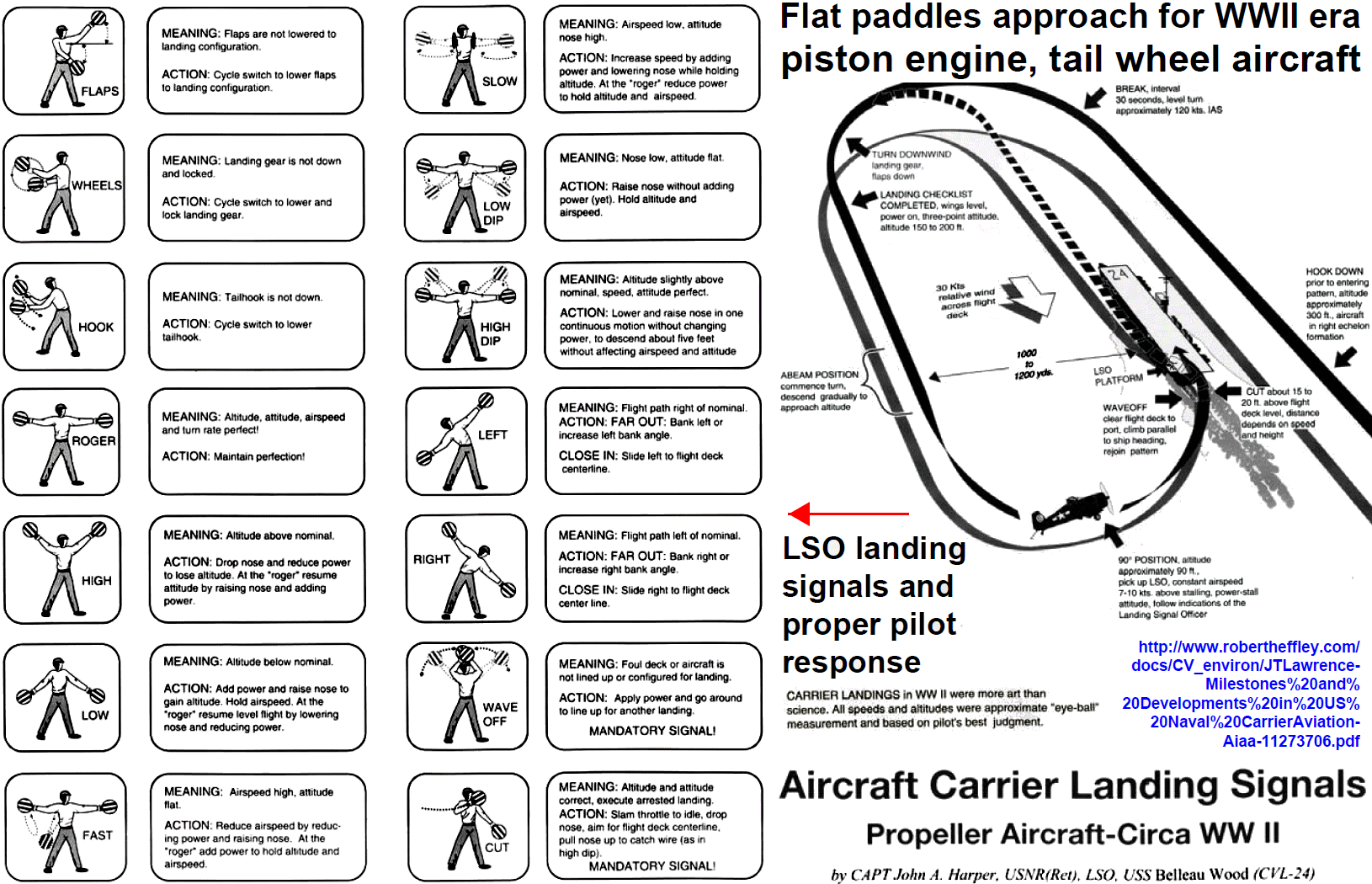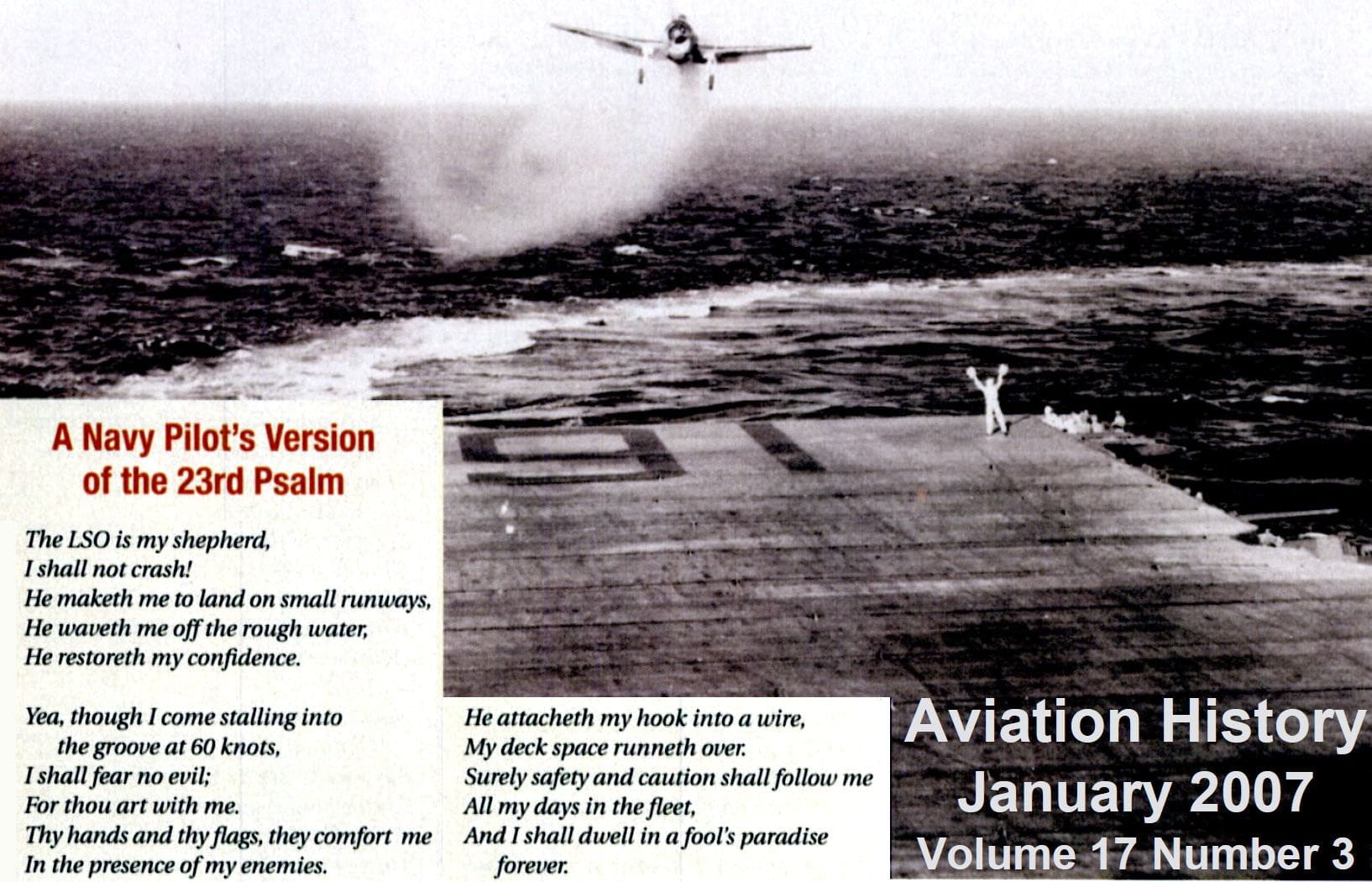Ex-FAA carrier pilot airborne again!
Thread Starter
Ex-FAA carrier pilot airborne again!
Navy Wings picked up the story of ex-Fleet Air Arm pilot 'Robbie' Robson - who is 97-years young - getting back behind the controls and into the air. Robbie flew Fairey Barracuda torpedo-bombers from the aircraft carrier HMS Venerable during the Second World War, and several other types, including Sea Mosquitos, before leaving the Navy. (As an aside, Venerable is possibly better known as the Argentinean aircraft carrier Veinticinco de Mayo). He's a great bloke and it was a real privilege to fly with him.
https://lnkd.in/eRYtbBgv
https://lnkd.in/eRYtbBgv
The following 2 users liked this post by DaveUnwin:
Join Date: Feb 2006
Location: Hanging off the end of a thread
Posts: 32,959
Received 2,858 Likes
on
1,225 Posts
Nice to see 

Join Date: Jul 2008
Location: Australia OZ
Age: 75
Posts: 2,581
Likes: 0
Received 52 Likes
on
45 Posts
Thanks Dave, Great story indeed. Nice details about a carrier approach for the BARRACUDA. Good comments otherwise.
“...This batsman from HMS Ravager, the Rudolf Nureyev of batsmen, is the most expressive of all as he lunges toward a landing Fleet Air Arm Fairey Barracuda like a joyful gazelle, welcoming the aircraft aboard. HMS Ravager (D70) was an Ruler class escort carrier built on the West Coast of the United States and operated by the Royal Navy during the Second World War. Ravager initially served as a convoy escort in the Atlantic theatre. Later in the war she was used mainly as a deck-landing training carrier and this photo is likely from that time as a training ship....”
Article: BODY ENGLISH — The Science and the Art of the LSO — Vintage Wings of Canada
PHOTO: BodyEnglish01.jpg (700×608) (squarespace-cdn.com)
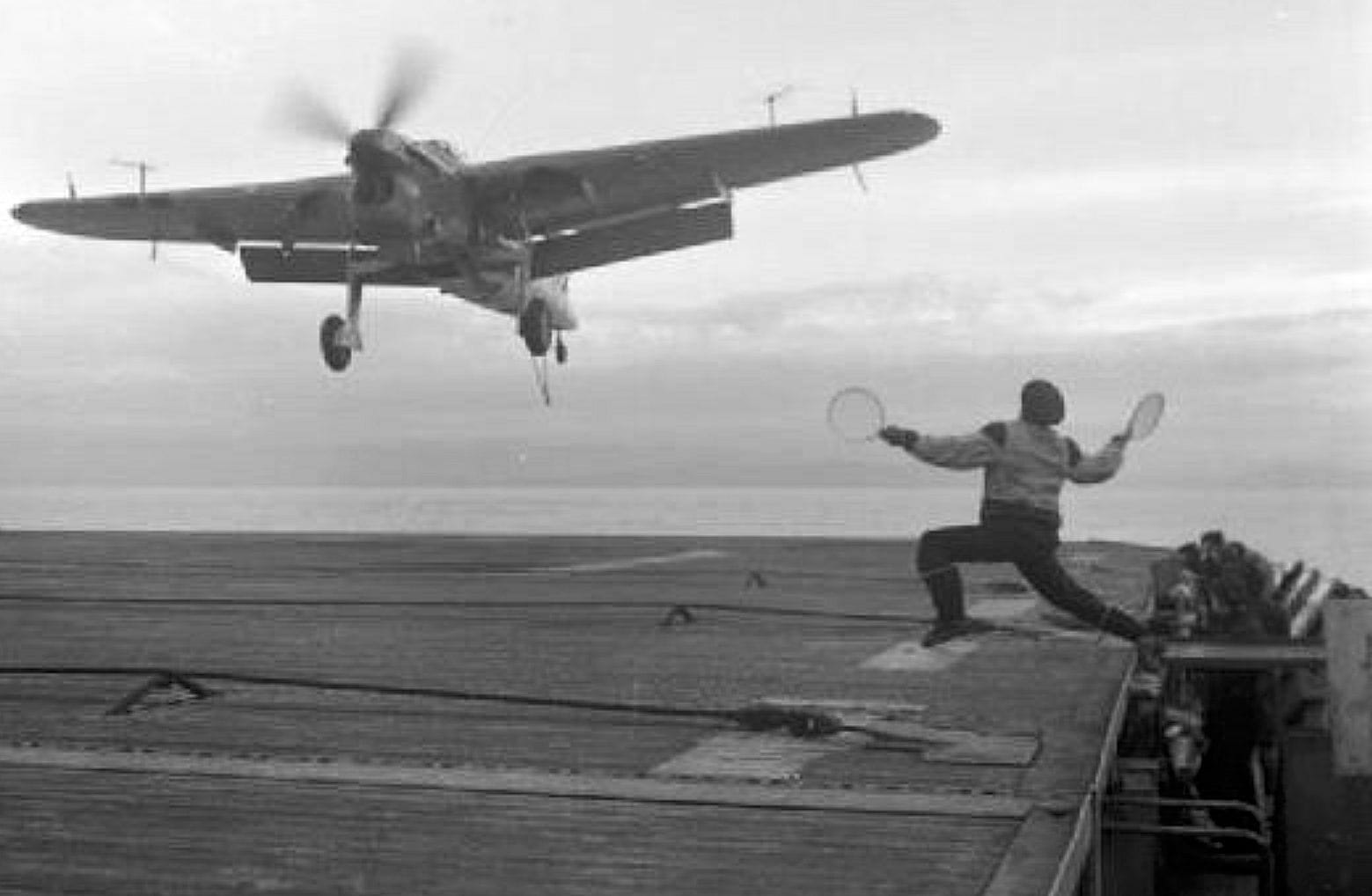
“...This batsman from HMS Ravager, the Rudolf Nureyev of batsmen, is the most expressive of all as he lunges toward a landing Fleet Air Arm Fairey Barracuda like a joyful gazelle, welcoming the aircraft aboard. HMS Ravager (D70) was an Ruler class escort carrier built on the West Coast of the United States and operated by the Royal Navy during the Second World War. Ravager initially served as a convoy escort in the Atlantic theatre. Later in the war she was used mainly as a deck-landing training carrier and this photo is likely from that time as a training ship....”
Article: BODY ENGLISH — The Science and the Art of the LSO — Vintage Wings of Canada
PHOTO: BodyEnglish01.jpg (700×608) (squarespace-cdn.com)

Last edited by SpazSinbad; 4th May 2023 at 08:15.
The following users liked this post:
Thanks Dave, Great story indeed. Nice details about a carrier approach for the BARRACUDA. Good comments otherwise.
“...This batsman from HMS Ravager, the Rudolf Nureyev of batsmen, is the most expressive of all as he lunges toward a landing Fleet Air Arm Fairey Barracuda like a joyful gazelle, welcoming the aircraft aboard. HMS Ravager (D70) was an Ruler class escort carrier built on the West Coast of the United States and operated by the Royal Navy during the Second World War. Ravager initially served as a convoy escort in the Atlantic theatre. Later in the war she was used mainly as a deck-landing training carrier and this photo is likely from that time as a training ship....”
“...This batsman from HMS Ravager, the Rudolf Nureyev of batsmen, is the most expressive of all as he lunges toward a landing Fleet Air Arm Fairey Barracuda like a joyful gazelle, welcoming the aircraft aboard. HMS Ravager (D70) was an Ruler class escort carrier built on the West Coast of the United States and operated by the Royal Navy during the Second World War. Ravager initially served as a convoy escort in the Atlantic theatre. Later in the war she was used mainly as a deck-landing training carrier and this photo is likely from that time as a training ship....”
Join Date: Jul 2008
Location: Australia OZ
Age: 75
Posts: 2,581
Likes: 0
Received 52 Likes
on
45 Posts
Towards the end of WWII the LSO/Paddles signals were standardized to be the same for both the RN & USN after some slight - but significant - differences were experienced when 'cross-decking'. First is an RN graphic, then I believe an USN text explanation of the following USN Paddles graphic of the LSO signals. The standard signals for both navies have not been found so far.... These graphics are in response to the text explanation for the 'CUT' signal in Dave's article. "...the batsman would whip both paddles across his body. This signal was called 'the cut' and like all the batsman's signals was mandatory...."
Probably there is room for the different LSOs to 'dance' differently on the platform. Some had nicknames/callsigns like 'MAGIC LEGS'. One such contemporary USN test pilot so named gave LSO lectures at a recent USN TAILHOOK convention.
One such contemporary USN test pilot so named gave LSO lectures at a recent USN TAILHOOK convention.

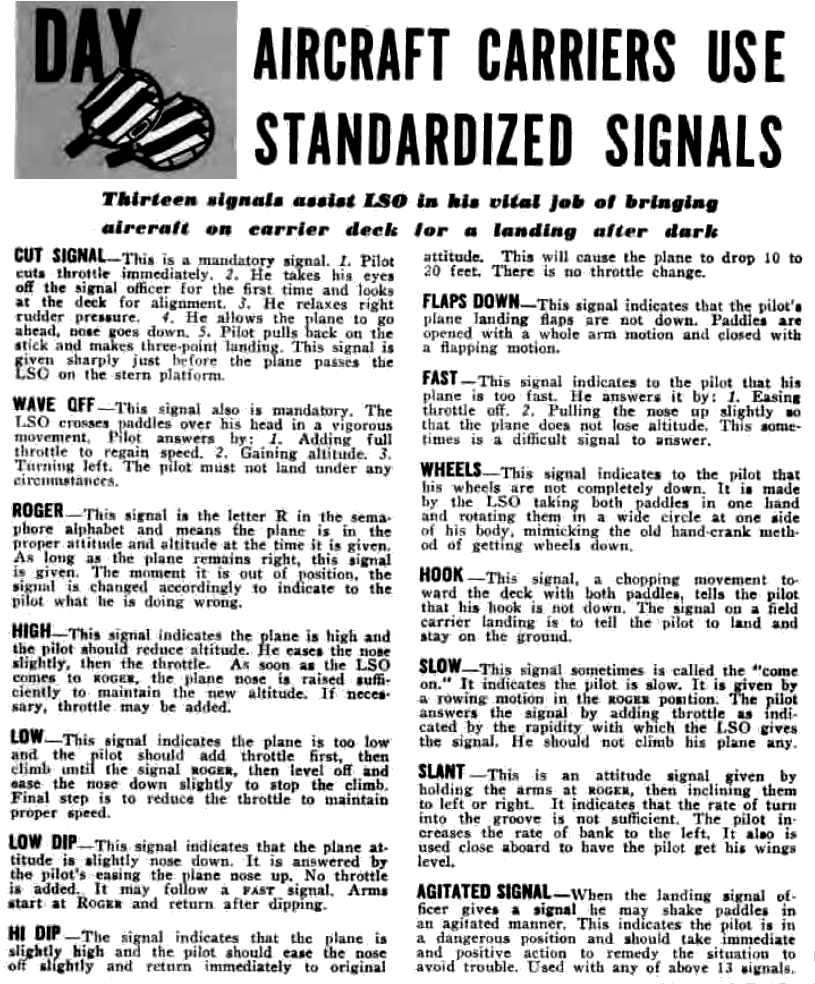

Probably there is room for the different LSOs to 'dance' differently on the platform. Some had nicknames/callsigns like 'MAGIC LEGS'.
 One such contemporary USN test pilot so named gave LSO lectures at a recent USN TAILHOOK convention.
One such contemporary USN test pilot so named gave LSO lectures at a recent USN TAILHOOK convention.


Join Date: Jul 2008
Location: Australia OZ
Age: 75
Posts: 2,581
Likes: 0
Received 52 Likes
on
45 Posts
This video is likely towards the end of WWII at the MONAB that would become NAS Nowra later. Video shows the 'cross-armed CUT'. Perhaps this CUT was part of the differences between RN FAA & USN also. I'll attach the FRENCH NAVY LSO signals also. During the initial Jet Straight Deck Landing era (before the mirror) the LSO also used a different cut it seems.
ADDLING LSO Paddles MONAB Dummy Deck WWII future Nowra
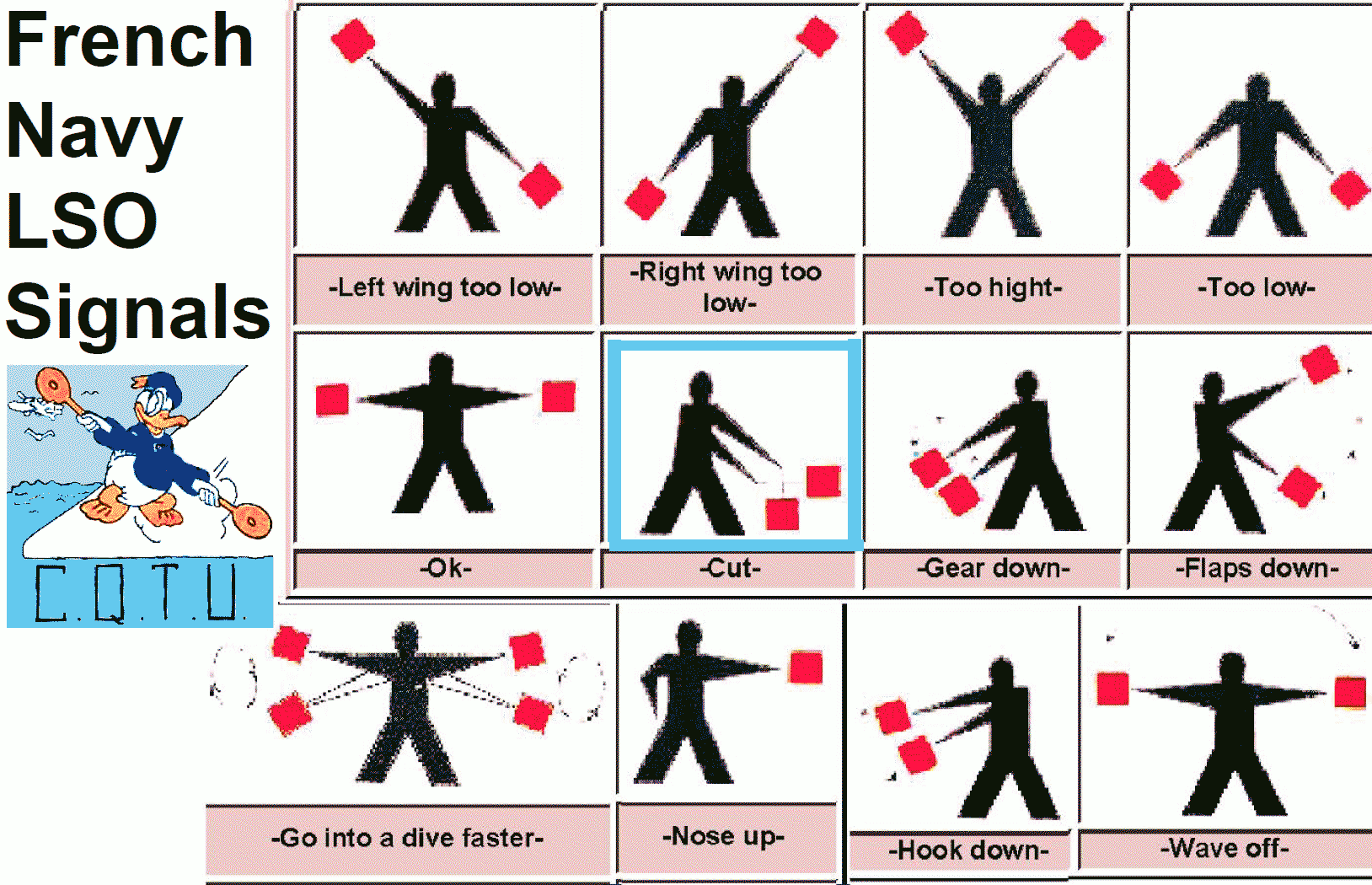
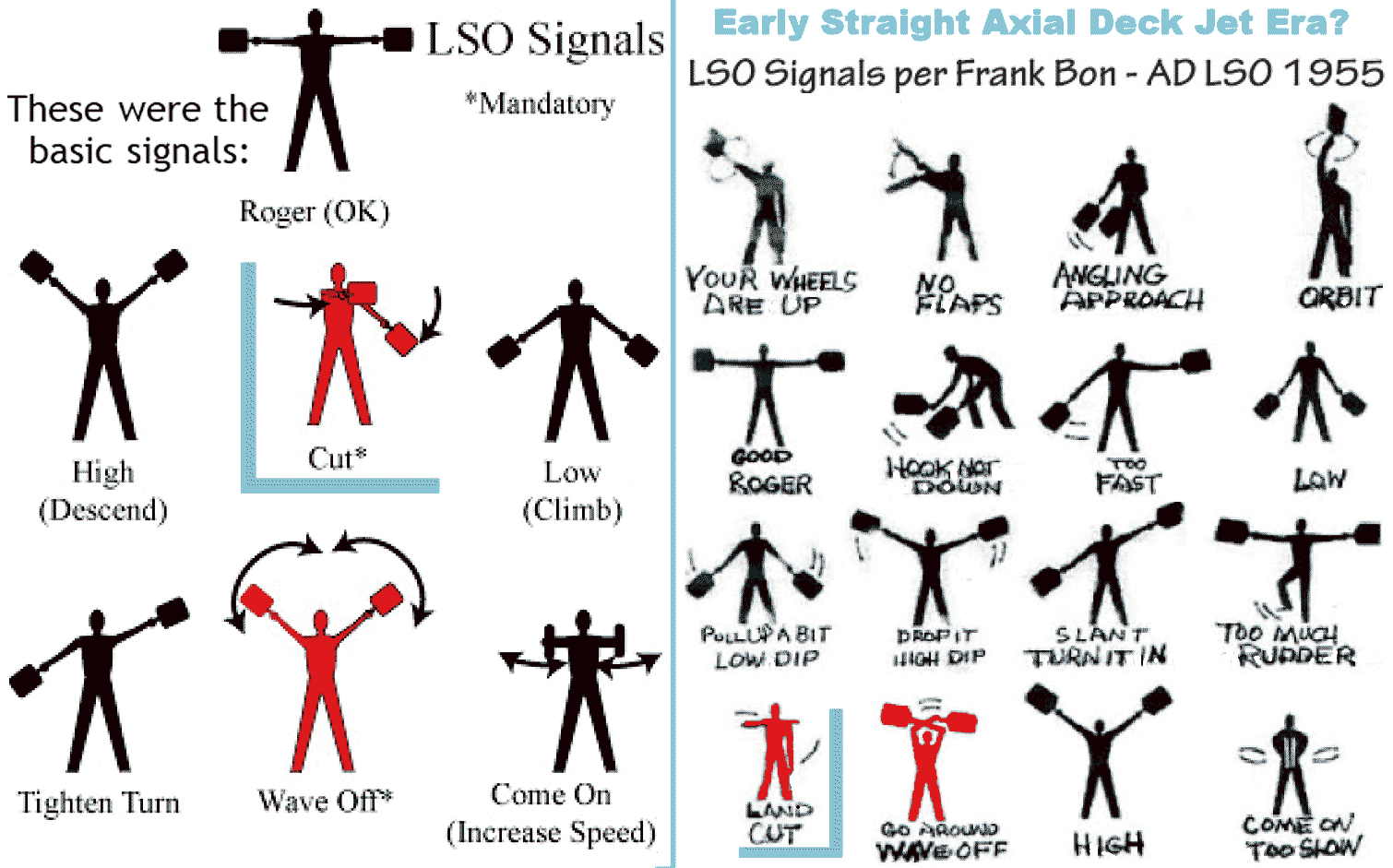
ADDLING LSO Paddles MONAB Dummy Deck WWII future Nowra


Last edited by SpazSinbad; 4th May 2023 at 17:29.
Join Date: Jul 2008
Location: Australia OZ
Age: 75
Posts: 2,581
Likes: 0
Received 52 Likes
on
45 Posts
Waving Them Aboard 04 May 2009
http://thanlont.blagspot.com.au/2009/05/waving-them-aboard.html
“...The LSO was one of the earliest innovations in landing aircraft aboard carriers. He stood on the port side of the deck near the ramp and by using a standard set of signals, assisted the pilot in touching down among the arresting wires at minimum speed and a low rate of descent.
For some reason, the Royal and U.S. Navies developed slightly different techniques for landing aboard. Royal Navy pilots were taught a descending approach and the LSO signal for the pilot being above the correct approach path was lowered paddles, meaning descend. The U.S. pilot made a low, flat approach and the LSO signal for being too high was raised paddles. (The signals for lineup were the same since the U.S. Navy signals for correcting height and lineup were inconsistent, like tilting down to the pilot's left to ask for tightening the turn and raising the paddles up for descend.) Fortunately, there was very little cross decking between the services during the war.
In 1948, the Royal Navy elected to change to the U.S. Navy LSO signals and shortly after that, adopted the low, flat approach as well. A reduction in accident rate resulted although it's not clear why. The British subsequently developed the mirror landing approach aid. The mechanics of the mirror concept combined the original British descending approach and the American signal for being too high, with the ball on the mirror going up when the airplane was above the desired "glide" slope.
Following the transition to the mirror-guided approach, the LSO role was initially downgraded to more of an administrative one in the belief that the pilot no longer needed his guidance. It was soon established that the LSO could detect a trend quicker than the pilot and moreover, had a better sense of deck motion, which affected the validity of the mirror display even though it was gyro stabilized. As a result, the LSO was again established as the controlling authority for the approach.”
http://thanlont.blagspot.com.au/2009/05/waving-them-aboard.html
“...The LSO was one of the earliest innovations in landing aircraft aboard carriers. He stood on the port side of the deck near the ramp and by using a standard set of signals, assisted the pilot in touching down among the arresting wires at minimum speed and a low rate of descent.
For some reason, the Royal and U.S. Navies developed slightly different techniques for landing aboard. Royal Navy pilots were taught a descending approach and the LSO signal for the pilot being above the correct approach path was lowered paddles, meaning descend. The U.S. pilot made a low, flat approach and the LSO signal for being too high was raised paddles. (The signals for lineup were the same since the U.S. Navy signals for correcting height and lineup were inconsistent, like tilting down to the pilot's left to ask for tightening the turn and raising the paddles up for descend.) Fortunately, there was very little cross decking between the services during the war.
In 1948, the Royal Navy elected to change to the U.S. Navy LSO signals and shortly after that, adopted the low, flat approach as well. A reduction in accident rate resulted although it's not clear why. The British subsequently developed the mirror landing approach aid. The mechanics of the mirror concept combined the original British descending approach and the American signal for being too high, with the ball on the mirror going up when the airplane was above the desired "glide" slope.
Following the transition to the mirror-guided approach, the LSO role was initially downgraded to more of an administrative one in the belief that the pilot no longer needed his guidance. It was soon established that the LSO could detect a trend quicker than the pilot and moreover, had a better sense of deck motion, which affected the validity of the mirror display even though it was gyro stabilized. As a result, the LSO was again established as the controlling authority for the approach.”
Thanks Dave, Great story indeed. Nice details about a carrier approach for the BARRACUDA. Good comments otherwise.
...This batsman from HMS Ravager, the Rudolf Nureyev of batsmen, is the most expressive of all as he lunges toward a landing Fleet Air Arm Fairey Barracuda like a joyful gazelle, welcoming the aircraft aboard. HMS Ravager (D70) was an Ruler class escort carrier built on the West Coast of the United States and operated by the Royal Navy during the Second World War. Ravager initially served as a convoy escort in the Atlantic theatre. Later in the war she was used mainly as a deck-landing training carrier and this photo is likely from that time as a training ship....
Article: BODY ENGLISH The Science and the Art of the LSO Vintage Wings of Canada
PHOTO: BodyEnglish01.jpg (700×608) (squarespace-cdn.com)

...This batsman from HMS Ravager, the Rudolf Nureyev of batsmen, is the most expressive of all as he lunges toward a landing Fleet Air Arm Fairey Barracuda like a joyful gazelle, welcoming the aircraft aboard. HMS Ravager (D70) was an Ruler class escort carrier built on the West Coast of the United States and operated by the Royal Navy during the Second World War. Ravager initially served as a convoy escort in the Atlantic theatre. Later in the war she was used mainly as a deck-landing training carrier and this photo is likely from that time as a training ship....
Article: BODY ENGLISH The Science and the Art of the LSO Vintage Wings of Canada
PHOTO: BodyEnglish01.jpg (700×608) (squarespace-cdn.com)

Join Date: Jul 2008
Location: Australia OZ
Age: 75
Posts: 2,581
Likes: 0
Received 52 Likes
on
45 Posts
Thanks again Dave for the inspiring story. There is a LOT of LSO material (mostly more contemporary - so no flag waving) in my BIG PDF online available for a free download and always being updated. Having collected a lot more material about the paddling days - on and off - I never got around to attempt to fathom the many differences, until now. I'm still confoozzed.  Go here for BIG PDF download instructions but for a notso recent old PDF version: SpazSinbad A4G - Fleet Air Arm Association of Australia (faaaa.asn.au)
Go here for BIG PDF download instructions but for a notso recent old PDF version: SpazSinbad A4G - Fleet Air Arm Association of Australia (faaaa.asn.au)
The most recent version URL for a direct download: (I'll upload a new version today)
A4G RAN FAA Aircraft & Others 03 May 2023 pp20,225.pdf (3.5GB) [free direct download - please follow the instructions above - only viewable AFAIK - with [b]Adobe Acrobat Reader DC 64 bits.]
https://1drv.ms/b/s!AuYHBzTWY83LgZJu...PQBTw?e=q3ZYXQ
 Go here for BIG PDF download instructions but for a notso recent old PDF version: SpazSinbad A4G - Fleet Air Arm Association of Australia (faaaa.asn.au)
Go here for BIG PDF download instructions but for a notso recent old PDF version: SpazSinbad A4G - Fleet Air Arm Association of Australia (faaaa.asn.au)The most recent version URL for a direct download: (I'll upload a new version today)
A4G RAN FAA Aircraft & Others 03 May 2023 pp20,225.pdf (3.5GB) [free direct download - please follow the instructions above - only viewable AFAIK - with [b]Adobe Acrobat Reader DC 64 bits.]
https://1drv.ms/b/s!AuYHBzTWY83LgZJu...PQBTw?e=q3ZYXQ
Last edited by SpazSinbad; 5th May 2023 at 00:32.
Thread Starter
Have you ever read Jeffrey Quill's account of 'taking the barrier' in a Sea Hurricane while landing on HMS Argus and being batted aboard by Robert Everett? Very interesting.
Join Date: Jul 2008
Location: Australia OZ
Age: 75
Posts: 2,581
Likes: 0
Received 52 Likes
on
45 Posts
ASLO (yes I know): U.S. Navy Aircraft History: Barriers and Barricades, One More Time (thanlont.blagspot.com)
&
U.S. Navy Aircraft History: Barricade and Barriers Example (thanlont.********.com)
https:/blogger.googleusercontent.com/img/b/R29vZ2xl/AVvXsEhQN8LfATU0mrORzXg_lrU8JkH_RdIefeL2WMclRKV23rnDQgJLmIu-VBsUIo8riYJq_dJxYBoT6mUviNRA2QqVYZFoV4kO6oJ4zjaYPRPEEXWsuTKL 0ObZKO_DM-xNM5U8387sEx1v5c4Ou2sV34UMt8joygcF-lTpE2nC5OfqCFZqPIMdr8N_NHto9g/w640-h446/Barricade%20and%20Barriers.jpg

Join Date: Jul 2008
Location: Australia OZ
Age: 75
Posts: 2,581
Likes: 0
Received 52 Likes
on
45 Posts
Aforementioned 'Magic Legs' LSO briefing at TAILHOOK 2015 (OMG that long ago) 
Super Hornet 'Magic Carpet' Brief LSO 'Magic Legs' TAILHOOK '15
__________________________
Super Hornet Magic Carpet 2015 Tailhook LSO 'Magic Legs' Brief

Super Hornet 'Magic Carpet' Brief LSO 'Magic Legs' TAILHOOK '15
Super Hornet Magic Carpet 2015 Tailhook LSO 'Magic Legs' Brief
Join Date: Jul 2008
Location: Australia OZ
Age: 75
Posts: 2,581
Likes: 0
Received 52 Likes
on
45 Posts
From Naval Aviation News Nov 1967 PDF:
https://www.history.navy.mil/researc.../november.html
Pilot view of the LSO on the platorm seen with right arm raised almost vertical and left arm horizontal - right leg white in colour.

https://www.history.navy.mil/researc.../november.html
Pilot view of the LSO on the platorm seen with right arm raised almost vertical and left arm horizontal - right leg white in colour.

Join Date: Jul 2008
Location: Australia OZ
Age: 75
Posts: 2,581
Likes: 0
Received 52 Likes
on
45 Posts
Very good description of 'how to deck land' on an axial deck with prop aircraft. The entire text is easily readable in the online PDF. Video has renowned from WWII/RAAF/FAA pilot Nat Gould describing same. There are two URLs for same article repeated.
The Art of Deck Landing in the Old Straight Days by Norman Lee (page 6 of PDF)
https://www.faaaa.asn.au/wp-content/...32-3-Sep21.pdf (2.5Mb)
"...Having received the cut, the throttle was rapidly closed and the nose was allowed to drop, which it did with the reduction in power, this gave you an instant view of the deck, enabling you to make minor adjustments in lining up, and to assess your height. This was the critical point of the whole of process of achieving a successful landing, the aim being to flare the aircraft into the three-point attitude, just over the deck, with zero vertical velocity. Done the properly, the result would ensure you hooked a wire...."
Also here: https://www.faaaa.asn.au/news-views/...ck-operations/
&
https://www.faaaa.asn.au/wp-content/...k-Ops-v1-1.pdf
HMAS Sydney DLs Nat Gould Explanation
The Art of Deck Landing in the Old Straight Days by Norman Lee (page 6 of PDF)
https://www.faaaa.asn.au/wp-content/...32-3-Sep21.pdf (2.5Mb)
"...Having received the cut, the throttle was rapidly closed and the nose was allowed to drop, which it did with the reduction in power, this gave you an instant view of the deck, enabling you to make minor adjustments in lining up, and to assess your height. This was the critical point of the whole of process of achieving a successful landing, the aim being to flare the aircraft into the three-point attitude, just over the deck, with zero vertical velocity. Done the properly, the result would ensure you hooked a wire...."
Also here: https://www.faaaa.asn.au/news-views/...ck-operations/
&
https://www.faaaa.asn.au/wp-content/...k-Ops-v1-1.pdf
HMAS Sydney DLs Nat Gould Explanation




